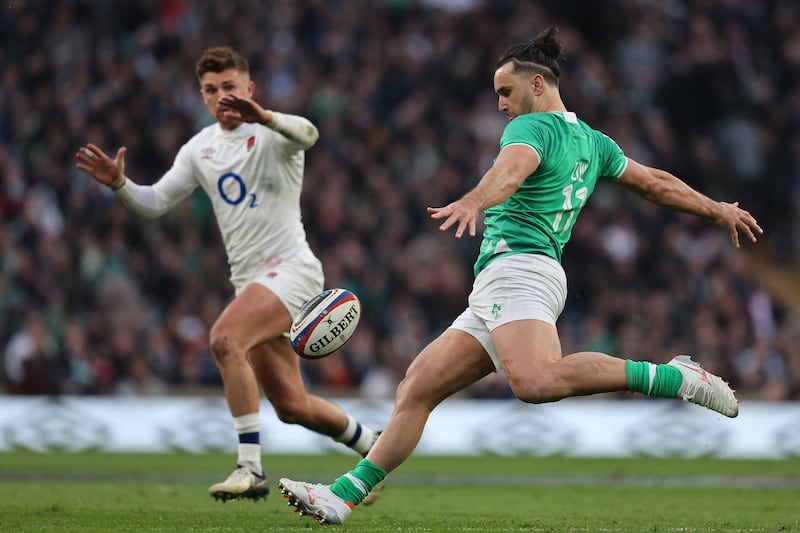There’s always an officiating decision – or lack thereof – to be discussed.
Twenty-three minutes into Ireland’s defeat on Saturday, Ellis Genge entered a ruck at blistering speed to clear out Tadhg Furlong. One could question the legality of the entry alone – was it in the side? – but then the Irish prop was sent flying back clutching his face.
Replays were not shown on the live television coverage, but on social media questions have been asked given the suspicion of head contact and foul play.
On the live angle, there are too many bodies in the way to see whether Genge clearly caught his head; Furlong’s reaction is all we have. Hardly conclusive evidence.
Seconds after, Genge was hit in a double tackle by Joe McCarthy and Caelan Doris. While on the ground, he screamed at referee Nika Amashukeli that he was hit in the head.
It remains unclear whether either collision was picked up by the TMO sweeping in the background. Moments later, the TMO was busy ruling out an Ollie Lawrence try due to a knock-on. While that check was ongoing, the ref mic picked up an English voice, presumably Jamie George’s, asking to check that potential high tackle on Genge. Amashukeli’s reply could not be heard clearly.
Even if the clearout and tackle were indeed picked up and angles shown to the TMO absolved all involved of wrongdoing – difficult to envisage given Ben Whitehouse had a potential try and two questions of foul play to deal with inside a minute – the on-sofa fan remains none the wiser.
Either incident could have led to cards that aided either team and that fact highlights an issue of fans, and players, not having full confidence that every incident of potential dangerous play is being dealt with.
A sport that continues to clamp down on head contact cannot afford to miss two such incidents all because the TMO is preoccupied with a potential try. The resulting information vacuum causes the game to suffer.
Irish abroad
Kildare native Cormac Daly turned plenty of heads on social media on Saturday morning after his Queensland Reds side upset the Chiefs in Super Rugby Pacific.
The Reds, coached by former Ireland defensive guru Les Kiss, beat many people’s favourites for this year’s Super Rugby crown 25-19 at Suncorp Stadium, Brisbane, one of the venues for next year’s Lions tour.
“I can’t wait to get in there and have a few beers with the lads,” an ecstatic Daly said to the broadcaster after the win. “That’s what it’s all about, it’s special. You don’t get wins like these that often, we have to soak it in now. It’s unbelievable, I’m so happy
“My head’s blown now, unbelievable craic, I’m so happy.”
Daly’s jubilation probably reflected the disbelief at the position he has found himself in during his time in Australia. A former Ireland under-20 international, the lock moved to Sydney to play club rugby for Coogee with no inkling he could progress into the professional ranks.
Daly had previously trained with Connacht only to miss out on a contract due to Covid-induced financial uncertainty, while he spent a preseason with Leinster in 2022. Playing for Clontarf in the AIL, he was player of the match in the final that same year when his side beat Terenure.
He did play for Leinster once, one of a number of club players given an opportunity when the province played Chile in 2022.
Ireland’s kicking costs them dear

Conor Murray has come in for plenty of harsh criticism for his decision to kick the ball away with just over a minute left on the clock on Saturday. From the resulting lineout, England made plenty of ground and ultimately kicked the winning drop goal.
While such criticism ignores Ireland’s poor first phase defence after that kick, and the fact that Murray was in his own 22 when he cleared, it is worth looking at the extent to which Ireland’s kicking game cost them more generally.
Ireland kicked more often (28 v 23 kicks) and for more ground (948.2 metres v 605.9m) than England. Only roughly 20 per cent of the time does an international side kick for more metres and still lose.
Despite the quantity, England secured as much as 60 per cent territory, with 37 per cent of the game taking place in the Irish 22. Ireland kicked long – as opposed to short and contestable – 61 per cent of the time. England’s back three feasted given a less than stellar chase, Immanuel Feyi-Waboso, George Furbank and Tommy Freeman accounting for nearly 40 per cent of England’s total metres carried.
Stark examples of failed execution could be found before England’s first two tries. Ollie Lawrence’s opener came off the back of a James Lowe clearance that failed to find touch. Furbank’s second-half effort similarly came off a Jamison Gibson-Park kick that didn’t find touch, England running back at a disorganised defensive line.
On both occasions, it seems clear the players were trying to find touch but didn’t, reflecting a wider pattern given that 12 points came from poorly executed kicks. In a rare blip for Ireland, their kicking strategy saw quantity, but not enough quality.
Word of Mouth
“Just ‘How are you doing, Steve? Nice to see you again. Not spoke to you for a long time.’ All good.” Andy Farrell on the half-time exchange between himself and Steve Borthwick that was picked up by TV cameras.
By the Numbers: 13
UL Bohs unbeaten run in the women’s AIL. Aoife Corey’s late try saw them snatch victory over Blackrock College, preserving their streak with a 17-15 win.
















